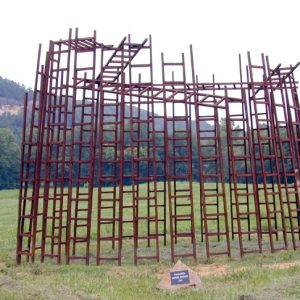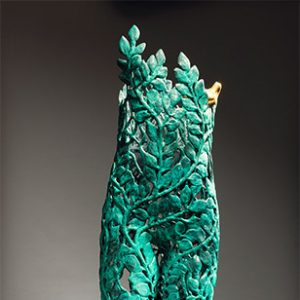calsfoundation@cals.org
Michael Warrick (1950–)
Michael Warrick is a sculptor who was recognized in 2020 by the Arkansas Arts Council as one of the state’s living treasures for his educational endeavors and his work creating site-specific sculptures. From 1990 to 2022, he taught courses in design, drawing, and sculpture at the University of Arkansas Little Rock (UA Little Rock). Among his best-known works in the central Arkansas area are the Central High Commemorative Garden (2001), Seed of Hope (2010; Winthrop P. Rockefeller Cancer Institute, University of Arkansas for Medical Sciences Medical Center), Celebrate (2014; Central Arkansas Library System), Straight Lines on a Round World (2017; Little Rock Statehouse Convention Center); and works for Changchun, China, and Hanam, South Korea, as part of Little Rock (Pulaski County) sister city relationships.
Born on October 1, 1950, Michael Warrick grew up in Morris, Illinois, the middle of three children of Robert and Ninalee Warrick. His interest in art during elementary and high school led his father to engage a local art teacher for instruction, and he routinely bought books about drawing and art. After high school, he worked in construction and factories and became certified in welding. He attended Illinois State University in Normal, receiving a BS in 1977, with a major in ceramics. After a few years continuing work as a welder, he attended Southern Illinois University Edwardsville, receiving an MFA in 1983. There, he majored in ceramics and sculpture and minored in drawing and art history. Warrick was married to Judy Lohmar from 1989 to 2020; they are the parents of Annika and Philip.
Warrick began his academic career at South Dakota State University in Brookings, where he was an assistant professor from 1987 to 1990. He was hired by UA Little Rock in 1990, where, prior to his retirement from full-time work in 2022, he advanced through the ranks to full professor.
Making a career combining teaching with his creative work was a perfect fit for Warrick. Two characteristics seen in his art are a curiosity about the context and setting in which each work is placed, and a fascination with the mechanics of putting together large-scale work that will both complement and withstand its environment. For each of his own works, he had to find appropriate materials, forms, and techniques, and as a teacher, he routinely demonstrated to students these types of techniques and approaches.
Warrick’s solo exhibition The Astronomers’ Dream was displayed at what is now the Arkansas Museum of Fine Arts in 1996; the exhibition also traveled to other venues. Its premise was youthful visions of life’s work ahead. The environment encompassed many different materials, including recycled items, and offered visitors both a literal and metaphorical journey through space. The fragmented figure is a theme that shows up in other works, reflecting the artist’s interest in both the use of tradition and having a figural element as something with which a viewer can empathize. Likewise, the concept of travel and thinking of art as a way to move across time and space are characteristics seen in some later work. A reviewer at the time noted the sense of optimism, order, and mastery of one’s surroundings. In 2021, Spirits, at the University of Arkansas at Little Rock Maners-Pappas Gallery, was an environment of cast meditation portraits that recalled parts of his 1996 work.
An important commission was the Central High Commemorative Garden (2001), a reflection on the 1957 Central High desegregation crisis. Warrick was inspired particularly by the photographs of Will Counts documenting those days. Warrick planned the garden and placed an arched structure inside, the form of which echoes the façade of the high school building. Photo collages printed on plastic are affixed to the reflective stainless steel structure. The work includes images of the Little Rock Nine, along with nine benches and nine trees within the garden.
Though Seed of Hope (2010) at the UAMS Medical Center is very different in appearance and scale from the Central High work, it shares with it a focus on reflection, acknowledging the fragility of human existence, while also emphasizing an outlook of hope for the future. This work presented Warrick with new technical challenges, particularly cutting, grinding, and polishing stone, for it was the largest in that medium he had attempted.
Celebrate was commissioned in 2010 and installed in 2014 to celebrate 100 years of the Central Arkansas Library System and, like other of Warrick’s site-specific works, was designed to reflect the spirit of the adjacent institution and those leading it. Made to appeal to children as well as adults, and to embody the concept of finding new ideas, worlds, and cultures through the resources of a major public library, the work resembles a spinning top, and has the word celebrate on its surface in forty-six languages. To create a work of this size and scale to spin easily, and to appear to be spinning while at rest, Warrick worked with an engineering firm.
Straight Lines on a Round World (2017), by Warrick and Louisiana artist Aaron Hussey, was a commission to mark the bicentennial anniversary of the Louisiana Purchase. The work’s imagery recalls the work of surveyors in 1815 who made the first survey of the Louisiana Territory.
Warrick has had several productive international trips as artist. Changchun, China, is the location of a monumental bust based in part on his research and discovery of local interests in 2008, also paying homage to traditional crafts and ceramics of the country. He went to Ireland in 2009 and was inspired by its landscape. Representing Little Rock in its sister city relationship, Warrick made a monumental bronze work for Hanam, South Korea, Youth (2018).
Other works include Dangerous Dreamers (1989; University of South Dakota); The Tree of Equality, Justice and Peace (2017; UALR); and Mockingbird Tree (2016, Chenal Parkway, Little Rock), a large stainless-steel work (which further inspired two similar works located in Whittier, California, and Southlake, Texas). He has also created numerous smaller works in a variety of media that are held by public, private, and corporate collections.
The Arkansas Arts Council named Warrick an Arkansas Living Treasure in 2020 in recognition of the impact his work as a teacher and artist have had on the state of Arkansas and beyond. The consistency in his work is not so much one of repeated design elements or choices, but is shown in his interest in making a work reflective of a particular community and moment in time.
For additional information:
“Art on the Move at Library Square.” CALS Roberts Library Blog. https://robertslibrary.org/blog/art-on-the-move-at-cals-library-square/ (accessed November 16, 2022).
Clancy, Sean. “Sculptured Skills.” Arkansas Democrat-Gazette, May 10, 2020, p. 1E.
“Michael Warrick: Clay, Metal, Stone, Wood.” Exhibition catalogue. Windgate Center for Art and Design, University of Arkansas at Little Rock, June 1–July 20, 2021.
Seymour, Gayle M. “Michael Warrick and The Astronomers’ Dream.” Southeastern College Art Conference Review 12, no. 5 (1995): 403–412.
University of Arkansas for Medical Sciences: “About the Seed of Hope.” https://cancer.uams.edu/patients-family/finding-your-way/services-amentites/about-the-seed-of-hope/ (accessed October 28, 2022).
Floyd W. Martin
University of Arkansas at Little Rock
 Arts, Culture, and Entertainment
Arts, Culture, and Entertainment Divergent Prosperity and the Arc of Reform, 1968–2022
Divergent Prosperity and the Arc of Reform, 1968–2022 Celebrate Sculpture
Celebrate Sculpture  Central High Commemorative Garden
Central High Commemorative Garden  Seed-of-Hope
Seed-of-Hope  Straight Lines on a Round World
Straight Lines on a Round World  Visionaries by Michael Warrick
Visionaries by Michael Warrick  Youth
Youth 



Comments
No comments on this entry yet.